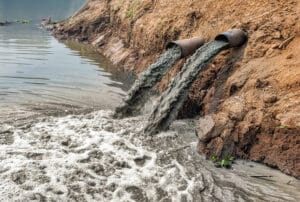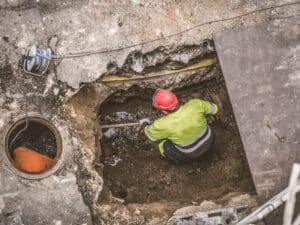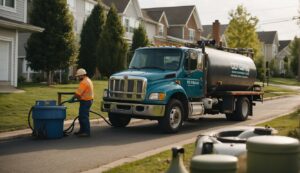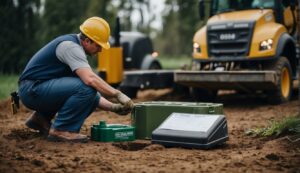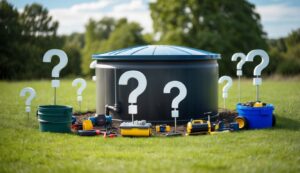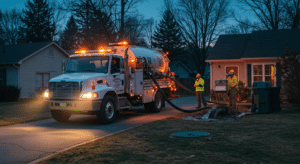Cesspools are an outdated underground wastewater system that have been banned from new construction in all 50 states and Puerto Rico. Cesspools can also be prone to emergencies that require immediate attention to prevent health and environmental issues.
Here are some of the most common cesspool emergencies and how to recognize them so that you can take prompt action to address the issue.
Cesspool Overflow
One of the most common cesspool emergencies is an overflow, which occurs when the cesspool becomes full and the wastewater has nowhere to go. This can happen for a number of reasons, such as a blockage in the system or excessive water usage in the household.
An overflowing cesspool can be a serious health hazard as it can contaminate drinking water sources and create a breeding ground for disease-carrying pests.
To recognize an overflowing cesspool, you should look for the following signs:
- Standing water or puddles near the cesspool
- A strong, unpleasant smell emanating from the area
- Insects or pests gathering around the cesspool
- A change in the water level of nearby streams or rivers
If you suspect that your cesspool is overflowing, you should immediately stop using any water-consuming appliances (such as washing machines and dishwashers) and call a professional to assess the situation.
Cesspool Collapse
Another common cesspool emergency is a collapse, which occurs when the walls of the cesspool give way and the contents of the tank spill out into the surrounding area. This can happen due to a variety of factors, including soil erosion, water infiltration, and structural damage.
A collapsed cesspool can be a major environmental hazard, as it can contaminate the soil and water and create a breeding ground for pests.
To recognize a collapsed cesspool, you should look for the following signs:
- Sinking or settling of the ground near the cesspool
- Cracks in the ground or in nearby structures
- A sudden increase in the water level of nearby streams or rivers
- A sudden influx of pests in the area
If you suspect that your cesspool has collapsed, you should immediately stop using any water-consuming appliances and call a professional to assess the situation.
Cesspool Blockage
A blockage in the cesspool can prevent wastewater from flowing out of the system, leading to an overflow or backup. Blockages can be caused by a variety of factors, including foreign objects, grease, and excessive toilet paper use. A blocked cesspool can be a serious health hazard, as it can create a breeding ground for disease-carrying pests and contaminate drinking water sources.
To recognize a blocked cesspool, look for the following signs:
- Slow or clogged drains
- Gurgling noises coming from the plumbing
- A strong, unpleasant smell emanating from the plumbing
- Water backing up into the household
If you suspect that your cesspool is blocked, you should stop using any water-consuming appliances and call a professional to assess the situation.
Cesspool Contamination
Cesspools can become contaminated if they are not properly maintained or if hazardous substances are disposed of in them. Contamination can occur when the cesspool becomes overwhelmed with solids, grease, or chemicals, leading to the growth of harmful bacteria and the release of toxic gases. Contamination can be a serious health hazard, as it can cause illness and even death.
To recognize a contaminated cesspool, you should look for the following signs:
- A strong, unpleasant smell emanating from the area
- The presence of hazardous materials near the cesspool
- Signs of illness in people or animals living near the cesspool
- Changes in the color or clarity of nearby water sources
If you suspect that your cesspool is contaminated, you should immediately stop using any water-consuming appliances and call a professional to assess the situation.
General Cesspool Failure
Cesspools can also fail due to a variety of factors, including age, structural damage, and improper maintenance. A failed cesspool can be a serious health hazard, as it can release untreated wastewater into the environment and contaminate water sources.
To recognize a failed cesspool, you should look for the following signs:
- An overflowing or collapsed cesspool
- A strong, unpleasant smell emanating from the area
- Signs of illness in people or animals living near the cesspool
- Changes in the color or clarity of nearby water sources
If you suspect that your cesspool has failed, you should immediately stop using any water-consuming appliances and call a professional to assess the situation.
Cesspool emergencies can be serious health hazards that require immediate attention. The most important thing you can do is to recognize the signs of an overflowing, collapsed, blocked, contaminated, or failed cesspool, and take prompt action to address the issue and protect yourself, your household, and your community.
If you suspect that you are experiencing a cesspool emergency, you should stop using any water-consuming appliances and call a professional to assess the situation.
If you live in New York state and your cesspool has failed, you should consider contacting a company that specializes in nitrogen-reducing, Innovative/Advanced Onsite Wastewater Treatment System (I/A OWTS). These systems are designed to remove harmful nitrates before they enter the ground, and current

